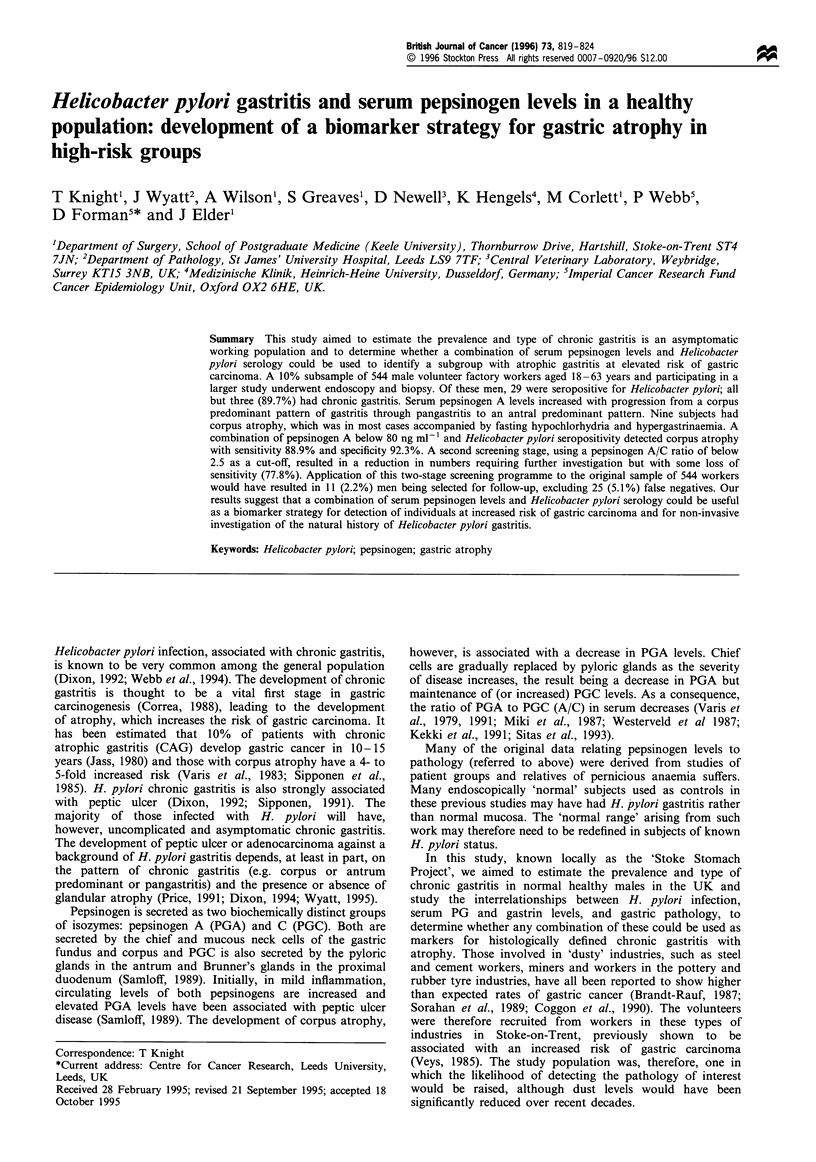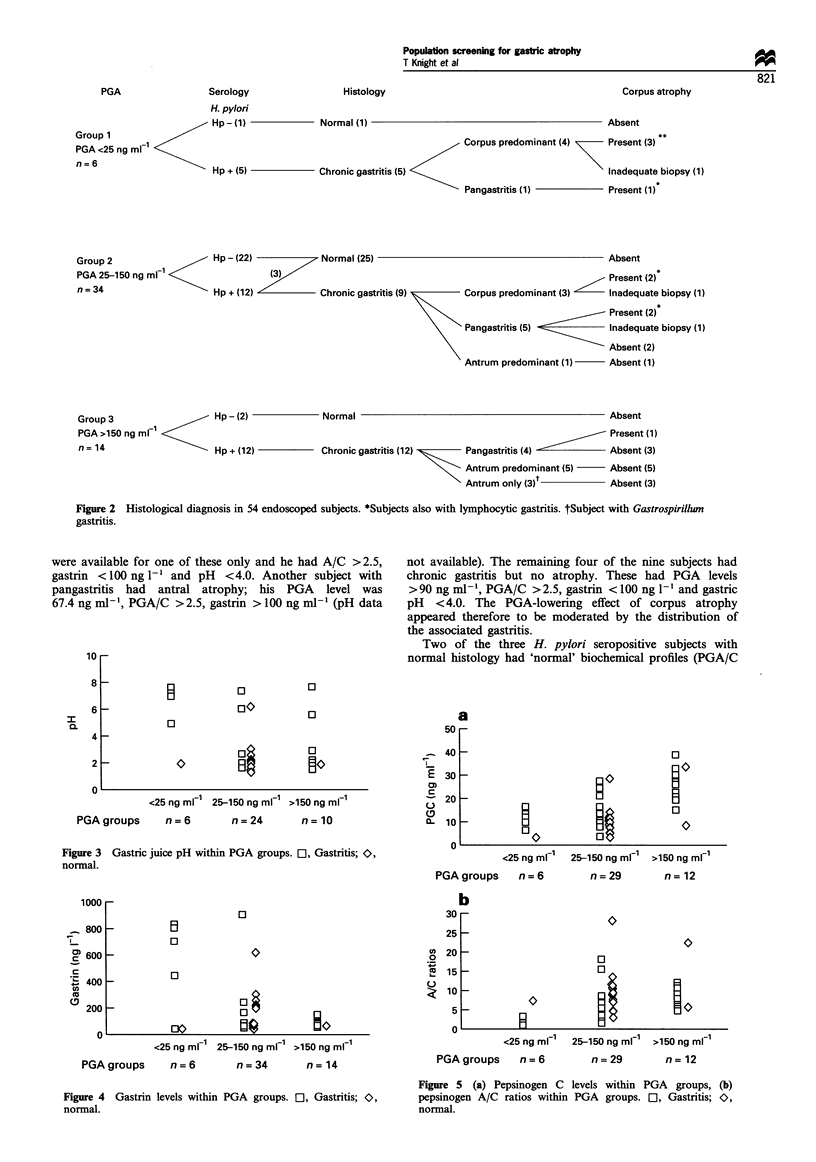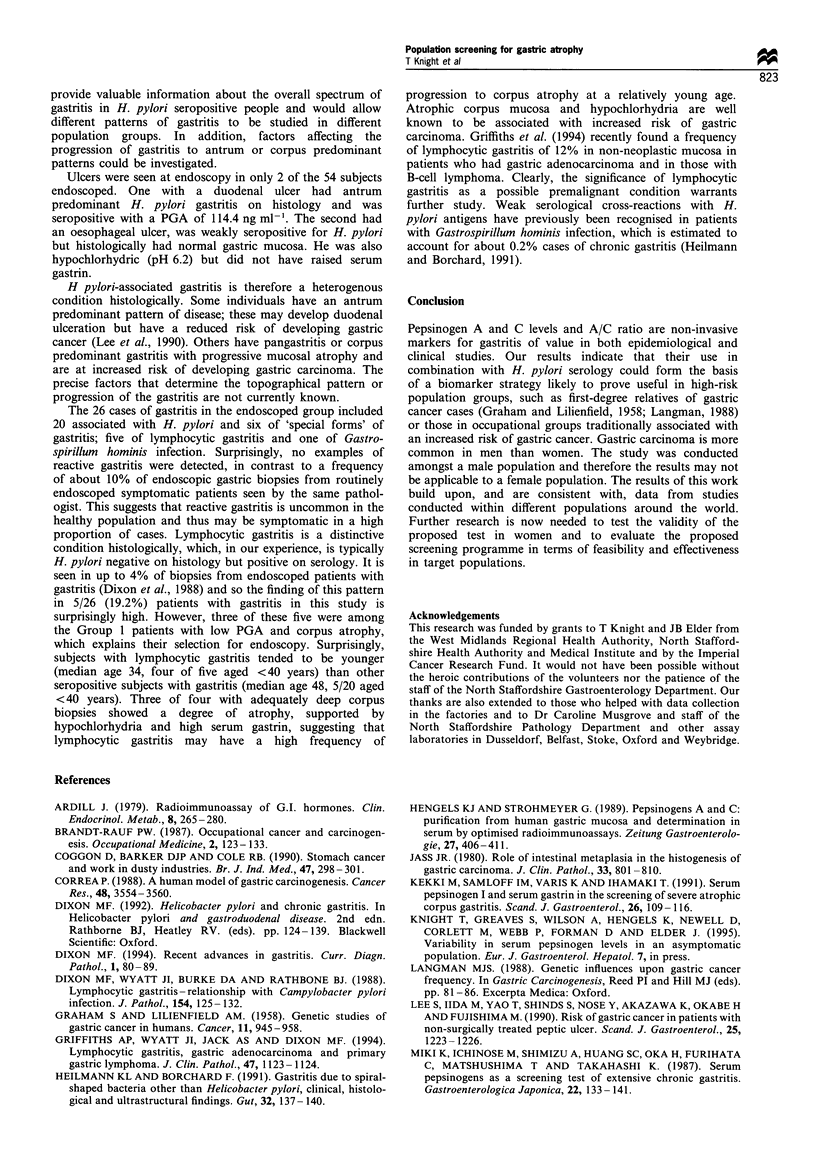Abstract
This study aimed to estimate the prevalence and type of chronic gastritis in an asymptomatic working population and to determine whether a combination of serum pepsinogen levels and Helicobacter pylori serology could be used to identify a subgroup with atrophic gastritis at elevated risk of gastric carcinoma. A 10% subsample of 544 male volunteer factory workers aged 18-63 years and participating in a larger study underwent endoscopy and biopsy. Of these men, 29 were seropositive for Helicobacter pylori; all but three (89.7%) had chronic gastritis. Serum pepsinogen A levels increased with progression from a corpus predominant pattern of gastritis through pangastritis to an antral predominant pattern. Nine subjects had corpus atrophy, which was in most cases accompanied by fasting hypochlorhydria and hypergastrinaemia. A combination of pepsinogen A below 80 ng ml-1 and Helicobaceter pylori seropositivity detected corpus atrophy with sensitivity 88.9% and specificity 92.3%. A second screening stage, using a pepsinogen A/C ratio of below 2.5 as a cut-off, resulted in a reduction in numbers requiring further investigation but with some loss of sensitivity (77.8%). Application of this two-stage screening programme to the original sample of 544 workers would have resulted in 11 (2.2%) men being selected for follow-up, excluding 25 (5.1%) false negatives. Our results suggest that a combination of serum pepsinogen levels and Helicobacter pylori serology could be useful as a biomarker strategy for detection of individuals at increased risk of gastric carcinoma and for non-invasive investigation of the natural history of Helicobacter pylori gastritis.
Full text
PDF





Selected References
These references are in PubMed. This may not be the complete list of references from this article.
- Ardill J. Radioimmunoassay of GI hormones. Clin Endocrinol Metab. 1979 Jul;8(2):265–280. doi: 10.1016/s0300-595x(79)80041-9. [DOI] [PubMed] [Google Scholar]
- Coggon D., Barker D. J., Cole R. B. Stomach cancer and work in dusty industries. Br J Ind Med. 1990 May;47(5):298–301. doi: 10.1136/oem.47.5.298. [DOI] [PMC free article] [PubMed] [Google Scholar]
- Correa P. A human model of gastric carcinogenesis. Cancer Res. 1988 Jul 1;48(13):3554–3560. [PubMed] [Google Scholar]
- Dixon M. F., Wyatt J. I., Burke D. A., Rathbone B. J. Lymphocytic gastritis--relationship to Campylobacter pylori infection. J Pathol. 1988 Feb;154(2):125–132. doi: 10.1002/path.1711540204. [DOI] [PubMed] [Google Scholar]
- GRAHAM S., LILIENFELD A. M. Genetic studies of gastric cancer in humans: an appraisal. Cancer. 1958 Sep-Oct;11(5):945–958. doi: 10.1002/1097-0142(195809/10)11:5<945::aid-cncr2820110512>3.0.co;2-7. [DOI] [PubMed] [Google Scholar]
- Griffiths A. P., Wyatt J., Jack A. S., Dixon M. F. Lymphocytic gastritis, gastric adenocarcinoma, and primary gastric lymphoma. J Clin Pathol. 1994 Dec;47(12):1123–1124. doi: 10.1136/jcp.47.12.1123. [DOI] [PMC free article] [PubMed] [Google Scholar]
- Heilmann K. L., Borchard F. Gastritis due to spiral shaped bacteria other than Helicobacter pylori: clinical, histological, and ultrastructural findings. Gut. 1991 Feb;32(2):137–140. doi: 10.1136/gut.32.2.137. [DOI] [PMC free article] [PubMed] [Google Scholar]
- Hengels K. J., Strohmeyer G. Pepsinogens A and C: purification from human gastric mucosa and determination in serum by optimized radioimmunoassays. Z Gastroenterol. 1989 Aug;27(8):406–411. [PubMed] [Google Scholar]
- Jass J. R. Role of intestinal metaplasia in the histogenesis of gastric carcinoma. J Clin Pathol. 1980 Sep;33(9):801–810. doi: 10.1136/jcp.33.9.801. [DOI] [PMC free article] [PubMed] [Google Scholar]
- Kekki M., Samloff I. M., Varis K., Ihamäki T. Serum pepsinogen I and serum gastrin in the screening of severe atrophic corpus gastritis. Scand J Gastroenterol Suppl. 1991;186:109–116. doi: 10.3109/00365529109103997. [DOI] [PubMed] [Google Scholar]
- Lee S., Iida M., Yao T., Shindo S., Nose Y., Akazawa K., Okabe H., Fujishima M. Risk of gastric cancer in patients with non-surgically treated peptic ulcer. Scand J Gastroenterol. 1990 Dec;25(12):1223–1226. doi: 10.3109/00365529008998557. [DOI] [PubMed] [Google Scholar]
- Miki K., Ichinose M., Ishikawa K. B., Yahagi N., Matsushima M., Kakei N., Tsukada S., Kido M., Ishihama S., Shimizu Y. Clinical application of serum pepsinogen I and II levels for mass screening to detect gastric cancer. Jpn J Cancer Res. 1993 Oct;84(10):1086–1090. doi: 10.1111/j.1349-7006.1993.tb02805.x. [DOI] [PMC free article] [PubMed] [Google Scholar]
- Miki K., Ichinose M., Shimizu A., Huang S. C., Oka H., Furihata C., Matsushima T., Takahashi K. Serum pepsinogens as a screening test of extensive chronic gastritis. Gastroenterol Jpn. 1987 Apr;22(2):133–141. doi: 10.1007/BF02774209. [DOI] [PubMed] [Google Scholar]
- Price A. B. The Sydney System: histological division. J Gastroenterol Hepatol. 1991 May-Jun;6(3):209–222. doi: 10.1111/j.1440-1746.1991.tb01468.x. [DOI] [PubMed] [Google Scholar]
- Samloff I. M. Peptic ulcer: the many proteinases of aggression. Gastroenterology. 1989 Feb;96(2 Pt 2 Suppl):586–595. doi: 10.1016/s0016-5085(89)80054-x. [DOI] [PubMed] [Google Scholar]
- Samloff I. M., Varis K., Ihamaki T., Siurala M., Rotter J. I. Relationships among serum pepsinogen I, serum pepsinogen II, and gastric mucosal histology. A study in relatives of patients with pernicious anemia. Gastroenterology. 1982 Jul;83(1 Pt 2):204–209. [PubMed] [Google Scholar]
- Sipponen P., Kekki M., Haapakoski J., Ihamäki T., Siurala M. Gastric cancer risk in chronic atrophic gastritis: statistical calculations of cross-sectional data. Int J Cancer. 1985 Feb 15;35(2):173–177. doi: 10.1002/ijc.2910350206. [DOI] [PubMed] [Google Scholar]
- Sitas F., Smallwood R., Jewell D., Millard P. R., Newell D. G., Meuwissen S. G., Moses S., Zwiers A., Forman D. Serum anti-Helicobacter pylori IgG antibodies and pepsinogens A and C as serological markers of chronic atrophic gastritis. Cancer Epidemiol Biomarkers Prev. 1993 Mar-Apr;2(2):119–123. [PubMed] [Google Scholar]
- Talley N. J., Newell D. G., Ormand J. E., Carpenter H. A., Wilson W. R., Zinsmeister A. R., Perez-Perez G. I., Blaser M. J. Serodiagnosis of Helicobacter pylori: comparison of enzyme-linked immunosorbent assays. J Clin Microbiol. 1991 Aug;29(8):1635–1639. doi: 10.1128/jcm.29.8.1635-1639.1991. [DOI] [PMC free article] [PubMed] [Google Scholar]
- Varis K., Kekki M., Härkönen M., Sipponen P., Samloff I. M. Serum pepsinogen I and serum gastrin in the screening of atrophic pangastritis with high risk of gastric cancer. Scand J Gastroenterol Suppl. 1991;186:117–123. doi: 10.3109/00365529109103998. [DOI] [PubMed] [Google Scholar]
- Varis K., Samloff I. M., Ihämaki T., Siurala M. An appraisal of tests for severe atrophic gastritis in relatives of patients with pernicious anemia. Dig Dis Sci. 1979 Mar;24(3):187–191. doi: 10.1007/BF01308427. [DOI] [PubMed] [Google Scholar]
- Webb P. M., Knight T., Greaves S., Wilson A., Newell D. G., Elder J., Forman D. Relation between infection with Helicobacter pylori and living conditions in childhood: evidence for person to person transmission in early life. BMJ. 1994 Mar 19;308(6931):750–753. doi: 10.1136/bmj.308.6931.750. [DOI] [PMC free article] [PubMed] [Google Scholar]
- Westerveld B. D., Pals G., Lamers C. B., Defize J., Pronk J. C., Frants R. R., Ooms E. C., Kreuning J., Kostense P. J., Eriksson A. W. Clinical significance of pepsinogen A isozymogens, serum pepsinogen A and C levels, and serum gastrin levels. Cancer. 1987 Mar 1;59(5):952–958. doi: 10.1002/1097-0142(19870301)59:5<952::aid-cncr2820590517>3.0.co;2-g. [DOI] [PubMed] [Google Scholar]


